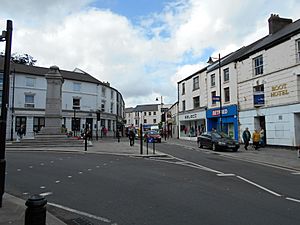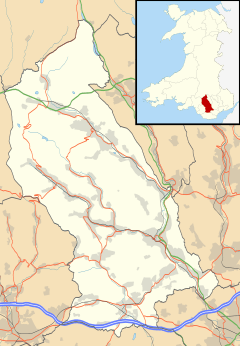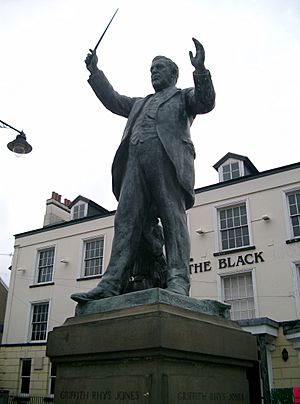Aberdare facts for kids
Quick facts for kids Aberdare
|
|
|---|---|
 Aberdare town centre |
|
| Population | 39,550 (Mid-2017 Estimate) |
| OS grid reference | SO005025 |
| Principal area |
|
| Ceremonial county | |
| Country | Wales |
| Sovereign state | United Kingdom |
| Post town | ABERDARE |
| Postcode district | CF44 |
| Dialling code | 01685 |
| Police | South Wales |
| Fire | South Wales |
| Ambulance | Welsh |
| EU Parliament | Wales |
| UK Parliament |
|
| Welsh Assembly |
|
Aberdare ( ab-ər-DAIR; Welsh: Aberdâr) is a town in the Cynon Valley area of Rhondda Cynon Taf, Wales, at the confluence of the Rivers Dare (Dâr) and Cynon. Aberdare has a population of 39,550 (mid-2017 estimate). Aberdare is 4 miles (6 km) south-west of Merthyr Tydfil, 20 miles (32 km) north-west of Cardiff and 22 miles (35 km) east-north-east of Swansea. During the 19th century it became a thriving industrial settlement, which was also notable for the vitality of its cultural life and as an important publishing centre.
Contents
History
Aberdare dates from the Middle Ages. It was originally a small village in an agricultural district, centred around the Church of St John the Baptist, said to date from 1189. By the middle of the 15th century, Aberdare contained a water mill in addition to a number of thatched cottages, of which no evidence remains. In the early 19th century the population grew rapidly, owing to the abundance of coal and iron ore,: the population of the whole parish, 1,486 in 1801, increased tenfold during the first half of the 19th century.
Two major industries supported the growth of the community: first iron, then coal. A branch of the Glamorganshire Canal (1811) was used to transport these products; then the railway became the main means of transport to the South Wales coast. From the 1870s onwards, the economy of the town was dominated by the coal mining industry, with only a small tinplate works. There were also several brickworks and breweries. During the latter half of the 19th century, considerable improvements were made to the town, which became a pleasant place to live, despite the nearby collieries. A postgraduate theological college opened in connection with the Church of England in 1892, but in 1907 it moved to Llandaff.
With the ecclesiastical parishes of St Fagan's (Trecynon) and Aberaman carved out of the ancient parish, Aberdare had 12 Anglican churches and one Roman Catholic church, built in 1866 in Monk Street near the site of a cell attached to Penrhys monastery; and at one time there were over 50 Nonconformist chapels (including those in surrounding settlements such as Cwmaman and Llwydcoed). The services in the majority of the chapels were in Welsh. Most of these chapels have now closed, with many converted to other uses. The urban district includes what were once the separate villages of Aberaman, Abernant, Cwmaman, Cwmbach, Cwmdare, Llwydcoed, Penywaun and Trecynon. There are several cairns and the remains of a circular British encampment on the mountain between Aberdare and Merthyr. Hirwaun moor, 4 miles to the north west of Aberdare, was according to tradition the scene of a battle at which Rhys ap Tewdwr, prince of Dyfed, was defeated by the allied forces of the Norman Robert Fitzhamon and Iestyn ap Gwrgant, the last Welsh prince of Glamorgan.
Population growth
The parish population was 1,486 in 1801, but expanded fast, especially during the 1840s and 1850s: the population of the Aberdare District, centred on the town, was 9,322 in 1841; 18,774 in 1851; and 37,487 in 1861. This population growth, a result of the growth of the steam coal trade (see below) was increasingly concentrated in the previously agricultural areas of Blaengwawr and Cefnpennar to the south of the town. Many of the migrants came from the rural parts of west Wales which had been affected by an agricultural depression. Population levels continued to increase over the next forty years, albeit with a small decline in the 1870s. The first decade of the 20th century saw a further sharp increase, largely as a result of the steam coal trade, reaching 53,779 in 1911. The population has since declined owing to the loss of most of the heavy industry.
Language
Welsh was the prominent language until the mid 20th century and Aberdare was an important centre of Welsh language publishing. A large proportion of the early migrant population were Welsh speaking, and in 1851 only ten per cent of the population had been born outside of Wales.
By 1901, the census recorded that 71.5% of the population of Aberdare Urban District spoke Welsh, but this fell to 65.2% in 1911. The 1911 data shows that Welsh was more widely spoken among the older generation compared to the young, and amongst women compared to men. A shift in language was expedited with the loss of men during the First World War and the resulting economic turmoil. English gradually began to replace Welsh as the community language, as shown by the decline of the Welsh language press in the town. This pattern continued after the Second World War despite the advent of Welsh medium education. Ysgol Gymraeg Aberdâr, the Welsh-medium primary school, was established in the 1950s with Idwal Rees as head teacher.
Culture
Aberdare, during its boom years, was considered a centre of Welsh culture: it hosted the first National Eisteddfod in 1861, with which David Williams (Alaw Goch) was closely associated. A number of local eisteddfodau had long been held in the locality, associated with figures such as William Williams (Carw Coch) The Eisteddfod was again held in Aberdare in 1885, and also in 1956 at Aberdare Park where the Gorsedd standing stones still exist. At the last National Eisteddfod held in Aberdare in 1956 Mathonwy Hughes won the chair. From the mid nineteenth century, Aberdare was an important publishing centre where a large number of books and journals were produced, the majority of which were in the Welsh language. A newspaper entitled Y Gwladgarwr (the Patriot) was published at Aberdare from 1856 until 1882 and was circulated widely throughout the South Wales valleys. From 1875 a more successful newspaper, Tarian y Gweithiwr (the Workman's Shield) was published at Aberdare by John Mills. Y Darian, as it was known, strongly supported the trade union movements among the miners and ironworkers of the valleys. The miners' leader, William Abraham, derived support from the newspaper, which was also aligned with radical nonconformist liberalism. The rise of the political labour movement and the subsequent decline of the Welsh language in the valleys, ultimately led to its decline and closure in 1934.
The Coliseum Theatre is Aberdare's main arts venue, containing a 600-seat auditorium and cinema. It is situated in nearby Trecynon and was built in 1938 using miners' subscriptions.
The Second World War poet Alun Lewis, was born near Aberdare in the village Cwmaman and there is a plaque commemorating him, including a quotation from his poem The Mountain over Aberdare.
The founding members of the rock band Stereophonics originated from the nearby village of Cwmaman. It is also the hometown of guitarist Mark Parry of Vancouver rock band The Manvils. Famed anarchist-punk band Crass played their last live show for striking miners in Aberdare during the UK miners' strike.
Griffith Rhys Jones − or Caradog as he was commonly known − was the Conductor of the famous 'Côr Mawr' of some 460 voices (the South Wales Choral Union), which twice won first prize at Crystal Palace choral competitions in London in the 1870s. He is depicted in the town's most prominent statue by sculptor Goscombe John, unveiled on Victoria Square in 1920.
21st Century Aberdare
Transport
The town is served by Aberdare railway station and Aberdare bus station, opposite each other in the town centre. The town has also been subject to an extensive redevelopment scheme during 2012–13.
Economy
With the decline of both iron and coal, Aberdare has become reliant on commercial businesses as a major source of employment. Its industries include cable manufacture, smokeless fuels, and tourism.
Colleges
- Coleg y Cymoedd
Primary schools
- Abernant Primary School
- Caradog primary school
- Town Church primary school
- St Margaret's Roman Catholic primary school
- Ysgol Gynradd Gymraeg Aberdar
- Blaengwawr Primary School
- Oaklands Primary School
- Cap Coach Primary School
- Glynhafod Primary School
- Cwmaman Infants School
- Cwmdare Primary School
- Aberdare Park Primary
- Cwmbach Community Primary School
Secondary schools
- Aberdare Community School
- St. John the Baptist School (Aberdare)
- Ysgol Gyfun Rhydywaun
Sports
Football
The town has a thriving football scene with many grassroots clubs for both senior and junior players, while historically Aberdare Athletic F.C. were members of the Football League between 1921 and 1927 before being replaced by Torquay United after finishing bottom. The senior club folded a year later. They played their football league games at the Aberdare Athletic Ground where the current Ynys Stadium stands today. The reserve team carried on as Aberaman and Aberdare Athletic for one more season and were known as Aberaman Athletic F.C prior to being renamed as Aberdare Town. They play in the South Wales Alliance Premier League at Aberaman Park.
Current football clubs in the area include:
- AFC Llwydcoed
- FC Cwmaman
- Hirwaun & Mackworth JFC
- Cwmbach Royal Stars FC
- FC Abercwmboi
Rugby Union
CurrentRugby Union clubs in the area include:
- Aberdare Rugby Football Club - formed in 1890 which still play in Aberdare today at the Ynys Stadium.
- Abercwmboi RFC
- Hirwaun RFC
Rugby League
The Aberdare Athletic Ground was the venue of the first rugby league international, played between Wales and the New Zealand All Golds on New Year's Day 1908, which was won by the Welsh 9–8.
Education
The state of education in the parish was a cause for concern during the early industrial period as is illustrated by the reaction to the 1847 Education Reports. Initially, there was an outcry, led by the Rev Thomas Price against the comments made by the vicar of Aberdare in his submission to the commissioners. However, on closer reflection, the reports related the deficiencies of educational provision, not only in Aberdare itself but also in the communities of the valleys generally. In so doing they not only criticised the ironmasters for their failure to provide schools for workers' children but also the nonconformists for not establishing British Schools. At the ten schools in Aberdare there was accommodation for only 1,317 children, a small proportion of the population. Largely as a result of these criticisms, the main nonconformist denominations worked together to establish a British School, known locally as Ysgol y Comin, which was opened in 1848, accommodating 200 pupils. Funds were raised which largely cleared the debts and the opening of the school was marked by a public meeting addressed by Price and David Williams (Alaw Goch).
Much energy was expended during this period on conflicts between Anglicans and nonconformists over education. The establishment of the Aberdare School Board in 1871 brought about an extension of educational provision but also intensified religious rivalries. School Board elections were invariably fought on religious grounds. Despite these tensions the Board took over a number of existing schools and established new ones. By 1889, fourteen schools were operated by the Board but truancy and lack of attendance remained a problem, as in many industrial districts.
In common with other public bodies at the time (see 'Local Government' above), membership of the School Board was dominated by coal owners and colliery officials, nonconformist ministers, professional men and tradesmen. Only occasionally was an Anglican clergyman elected and, with the exception of David Morgan (Dai o'r Nant), no working class candidates were elected for more than one term.
Colleges
- Coleg y Cymoedd
Secondary schools
- Aberdare Community School
- St. John the Baptist School (Aberdare)
- Ysgol Gyfun Rhydywaun
Transport
The town is served by Aberdare railway station and Aberdare bus station, opposite each other in the town centre. The town has also been subject to an extensive redevelopment scheme during 2012–13.
Notable people
- See also Category:People from Aberdare
Notable current and former residents and natives of Aberdare include:
- Henry Austin Bruce – 1st Baron Aberdare & Home Secretary (1868–1873)
- Les Cartwright - Former Association Footballer and Wales international, played for Coventry City and Wrexham AFC
- Rose Davies – Labour politician and feminist
- Ian Evans – Former Rugby Union Player and Wales international, played for Ospreys and Bristol. Currently coaching at the Dragons
- Lyn Evans – particle physicist and project leader of the Large Hadron Collider
- Ioan Gruffudd – actor, born in Llwydcoed, Aberdare
- Patrick Hannan (presenter) – broadcaster
- David "Tarw" Jones – Dual code rugby international
- Alun Lewis – War poet
- Arthur Linton - cyclist
- Lee Lucas - Association Footballer, played for Swansea City and Motherwell.
- 'Big' Jim Mills (rugby league) – Wales & Great Britain rugby league international
- John Morgan – Canadian comedian, Royal Canadian Air Farce
- Mihangel Morgan – Welsh language writer, born in Trecynon, some of his literary works feature Aberdare
- Roy Noble – Welsh broadcaster, has lived near Aberdare for the past 30 years
- R. Ifor Parry – Congregationalist Minister and schoolteacher
- Jason Price - Former Association Footballer, played for Swansea City and Doncaster Rovers
- Thomas Price (Baptist minister) – Baptist Minister and radical politician
- Ieuan Rhys – actor, from Trecynon
- Rhys Hopkin Rhys – 19th century industrialist and prominent local figure
- Rhian Samuel – composer and professor of music
- Bethan Sayed – member of the Senedd for the South Wales (West) Region
- Stereophonics – all three original members, Kelly Jones, Richard Jones and Stuart Cable were brought up in Cwmaman, Aberdare
- Rees Thomas - Former Association Footballer, played for Cardiff City, Bournemouth & Boscombe Athletic and Portsmouth
- Jo Walton – fantasy novelist, now living in Montreal, Quebec
- David Young – rugby player and coach, raised in Penywaun
Images for kids
See also
 In Spanish: Aberdare para niños
In Spanish: Aberdare para niños











